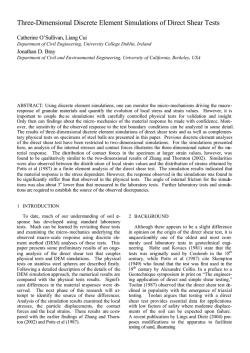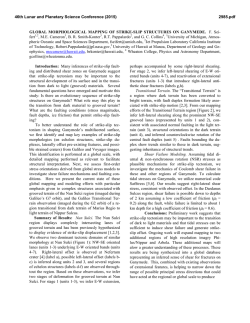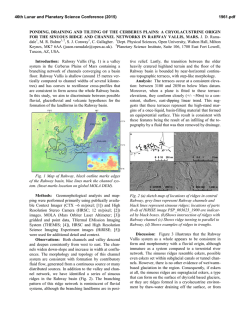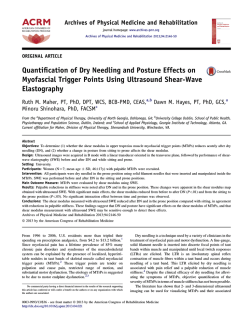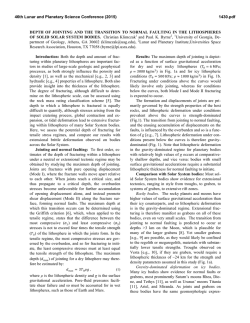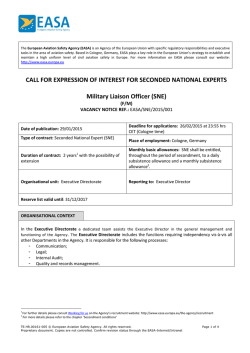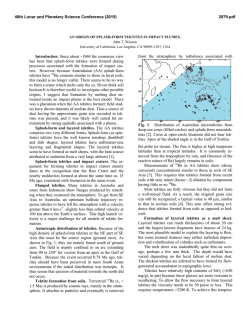
LIKELY SUSPECTS FOR WATER-VAPOR PLUME ERUPTIONS ON
46th Lunar and Planetary Science Conference (2015) 2952.pdf LIKELY SUSPECTS FOR WATER-VAPOR PLUME ERUPTIONS ON ICY SATELLITES. I. S. Curren1 and A. Yin1 1University of California Los Angeles, 595 Charles Young Drive East, Los Angeles, CA 90095-1567, [email protected]. Introduction: Water-vapor plumes have been observed near the south poles of Saturn’s icy satellite, Enceladus [1, 2], and Jupiter’s icy satellite, Europa [3]. On Enceladus, eposidic plumes are thought to emanate from a set of fractures, known as the ‘tiger stripes,’ [4] which exhibit temperatures higher that that of the surrounding terrain [2]. The five fractures are thought to be sites of active strike-slip or transtension/transpression tectonics resulting from cyclic tidal deformation [5]. During extensional or transtensional deformation phases, volatiles may be exposed allowing eruptions to occur [6]. Similar tectonic deformation is observed on Europa, which also presumably formed in response to temporally varying tidal stresses [e.g. 7, 8]. However, no connection has been made between specific fractures and the single identified water-vapor plume eruption [3]. This may be due to the paucity of high-resolution imagery near polar regions of Europa or the fact that subsequent plumes have not been detected [9]. However, an existing fracture in a specific orientation and location could be associated with the eruption [10]. To fully understand the apparent connection between fractures and plume eruptions, it is necessary to first understand the development and evolution of fractures on icy satellites. Shear deformation on icy satellites is thought to form via a tectonic process known as ‘tidal walking’, in which a fracture becomes tensile while in shear, followed by the fracture becoming compressive while in the opposite sense of shear [8]. This model makes a clear prediction of bidirectional cyclic shear and may be tested by analog modeling [11]. Here, we present an experimental model used to observe the kinematic evolution of cyclic deformation along fractures on icy satellites. We then compare those results to the apparent plume-source fractures observed at Enceladus’ south pole and fractures in the vicinity of Europa’s single detected plume. In this way we attempt to gain insight into structures associated with plume-source fractures and aim to identify additional fractures that could plausibly be eruptive. In the case of Europa, whose surface is pervasively fractured, and where the details of plume dynamics are poorly constrained [10], this is particularly important as more attempts are made to observe active plumes. Experimental Model: The tidal walking model [8] and subsequent more quantitative models [5, 12] have produced successful predictions of global strike-slip displacement on Europa and Enceladus. However, these models are unable predict the kinematic and structural development of offset fractures. To further our understanding of icy satellite fractures and their associated landforms (e.g., ridges) as well as their connection to eruptive plumes, we develop an experimental model to investigate the kinematic evolution of bidirectional cyclically sheared materials. The experimental apparatus, located in the UCLA Tectonics Laboratory, is comprised of two rigid aluminum base plates driven by a stepped gear motor that shear in parallel. For each experiment, we use dry heterogeneous sand, which has material properties that scale dynamically to the brittle lithospheric ice of Europa and Enceladus by the equation C* = ρ*g*h*, where C is cohesion, ρ is density, h is length, and * denotes model-to-nature ratio. For consistency, we use 2 cm of sand in our model for each experiment, which results in a dynamic scaling of 1 cm-to-2 km for Europa and 1 cm-to-10 km for Enceladus, which are feasible ice lithosphere depths for both bodies [13, 14]. We test a variety of shear displacement ratios, which can be grouped into two categories: no net offset and net offset. Velocity is held constant (1 mm/min) during each experiment. Results: Our experimental results indicate that fractures that are repeatedly sheared bidirectionally develop in a predictable manner. Regardless of shear displacement ratio, fractures always initiate with synthetic en échelon Riedel shears and associated pop-up structures, very similar to those formed during terrestrial strike-slip faulting [15]. Unlike terrestrial strikeslip faults, which tend to hold the form of initiating en échelon structures as displacement increases unidirectionally [15], the R-shears and pop-ups on fractures with imposed bidirectional shear begin to degrade after multiple cycles (Fig. 2). The degradation rate of en échelon R-shears and pop-ups is controlled by the shear displacement ratio and total offset per cycle utilized during experiments. Experiments with large displacement ratios (e.g., 4:1) degrade more slowly than experiments with small ratios (e.g., 1:1). Furthermore, experiments in which displacement ratios corresponded to large net offsets relative to the total length of the fault (0.7 m) resulted in more rapid degradation of R-shears. Ideally, to optimize simulation of icy satellite tectonics, one would kinematically (temporally) scale each cycle to the off- 46th Lunar and Planetary Science Conference (2015) set observed in the natural setting. However, estimates of displacement per orbit are poorly constrained for both satellites [5, 12] and the tectonic apparatus is mechanically limited by its stepped gear system. Regardless of scaling caveats, every experiment run during this project results in the development of a topographically low linear to curvilinear throughgoing fault (designated by the contact point between the two underlying aluminum plates) and topographically high fault-flanking ridges. Ridges are initially discontinuous following the trace of the en échelon structures. After repeated bidirectional shear, ridges become increasingly continuous along the fault-flanks. Conservation of mass requires that material in the initating en échelon pop-up structures must be redistributed as they are degraded; syntectonic development of fault-flanking ridges suggests that granular “smearing” is occurring. Discussion: The experiments in this study imply a predicatable progression of fault development in fracture system s which have initiated in and under gone cyclic bidirectional shear. This progression, although continuous, can be broken down into three stages: (1) Initiation – fractures in their initial stages exhibit en échelon structures; (2) Intermediate – fractures are throughgoing, but have discontinuous fault-flanking ridges; (3) Mature – fractures and ridges are both continuous. These fracture stages have been observed on Europa [11]. The ‘tiger stripes’ fractures at Enceladus’ pole have continuous troughs but discontinuous ridges and possible en échelon structure remnants (Fig. 1), making them “intermediate” by our fault progression stages. The resolution for the south pole of Europa is poor; however, the terminator of the satellite’s longest (810 km) fracture, Astypalae Linea, comes within 10º of the presumed south polar plume location [16]. Astypalaea Linea’s structure varies along strike, but long portions of the fracture are mature and transtensional [16]. Mature terrestrial strike-slip faults (e.g., San Andreas) have anomolously low fault friction and may penetrate deep into the Earth’s crust [17] while only slipping in one direction. If fractures on icy satellites follow the same fault friction patterns, then mature faults may have very low friction and could slip easily. In this scenario, laterally continuous ridge and fracture systems may be capable of releasing volatiles in an eruptive plume under the correct tidal conditions [6]. Low friction on these fractures does not support the plume production by frictional heating hypothesis [18]; however, Enceladus’ ‘tiger stripes’ fractures appear to be intermediate, indicating that friction may be higher in this location and that plumes on Europa and Enceladus may operate differently. Further investigation of Enceladus’ and Europa’s fractures needs to be con- 2952.pdf ducted to fully understand the source and implications of plume generation. References: [1] Porco C.C. et al. (2006) Science, 311, 1393-1401. [2] Porco C. C. et al. (2014) The Astronomical Journal, 148, 45. [3] Roth L. et al. (2014) Science, 343, 171-174. [4] Nimmo F. et al. (2014) The Astronomical Journal, 148, 46. [5] Smith-Konter B. and Papparlardo R. T. (2008) Icarus, 198, 435-451. [6] Hurford T. A. et al. (2007a) Nature, 447, 292-294. [7] Greenberg R. et al. (1998) Icarus, 135, 64-78. [8] Hoppa G. et al. (1999) Icarus, 141, 287-298. [9] Roth L. et al. (2014) AGU XLVII, Abstract #P52A-05. [10] Rhoden A. R. et al., (2014) DPS XLVI, Abstract #405.04. [11] Curren I. S. et al. (2014) AGU XLVII, Abstact #P43B-3992. [12] Rhoden A. R. et al., (2012) Icarus, 218, 297-307. [13] Schenk P. and McKinnon W.B. (1989) Icarus, 79, 75-100. [14] Olgin J. G. et al. (2011) GRL, 38, L02201. [15] Sylvester A. G. (1988) GSA Bull., 100, 1666-1703. [16] Tufts B. R. et al. (1999) Icarus, 141, 53-64. [17] Lockner D.A. et al. (2011) Nature, 472, 82-85. [18] Nimmo F. et al. (2007) Nature, 447, 289-291. 10 km Figure 1. Enceladus’ south polar ‘tiger stripes’ display discontontinous double ridges bounding each fracture. We test if these ridges can be formed through cyclic tidal deformation in this study. Figure 2. Relationship between number of cycles and ridge width. At initiation, en échelon pop-ups are wide. Continued cycling results in thinning and “smearing” pop-ups into fault flanking ridges.
© Copyright 2025

![Download [ PDF ] - journal of evolution of medical and dental sciences](http://s2.esdocs.com/store/data/000508090_1-a9a933ff37237d5430f2b15a1b23af4a-250x500.png)
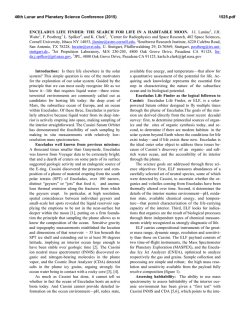
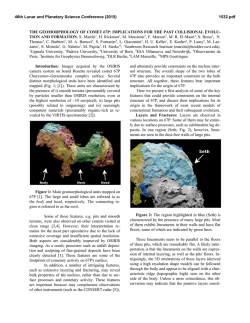
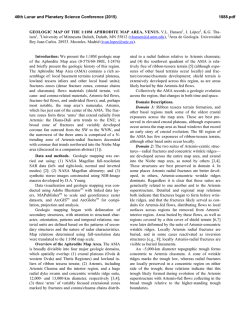
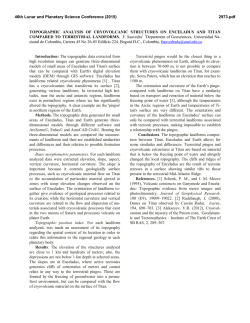
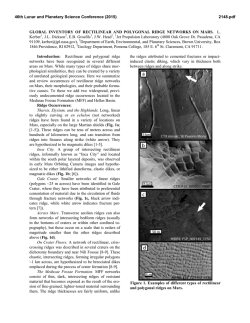

![Download [ PDF ] - journal of evidence based medicine and](http://s2.esdocs.com/store/data/000499424_1-04d992fdfa565a1fea9304f6c0faeaf7-250x500.png)
